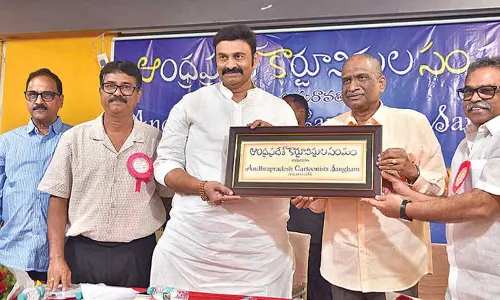"Capital" confusion

 Under pressure from Seemandhra Congress leaders, the High Command announced a high-level committee with Digvijay and Anthony to remove their apprehensions about revenue, water and safety during division of the State. In fact, their hidden agenda is to deny Telangana people of their capital, Hyderabad. It is unfortunate that Telangana parties, leaders and people are complacent about Hyderabad, which the Congress confused completely. The seeds of uncertainty about Hyderabad are sown in the CWC resolution itself, though written with ‘skilful diplomatic efficiency’. Is this confusion a deliberate strategy?
Under pressure from Seemandhra Congress leaders, the High Command announced a high-level committee with Digvijay and Anthony to remove their apprehensions about revenue, water and safety during division of the State. In fact, their hidden agenda is to deny Telangana people of their capital, Hyderabad. It is unfortunate that Telangana parties, leaders and people are complacent about Hyderabad, which the Congress confused completely. The seeds of uncertainty about Hyderabad are sown in the CWC resolution itself, though written with ‘skilful diplomatic efficiency’. Is this confusion a deliberate strategy?
Their hesitant assurance and doubtful commitment form part of their written statements, while Congress leaders leak everything ‘off the record’. Earlier, when they had a poll alliance with the TRC in 2004, they just ‘referred’ to the Telangana demand which later became controversial and revealed an escape route for them. The election manifesto, Presidential Address and even the declaration on December 9, 2009 were drafted with great diplomacy which did not lead to any commitment. The latest example is the resolution of the CWC on July 30. After arriving at a decision, the CWC resolution referred to some landmark commitments.
Then the resolution followed: “It is resolved to request the Central Government: To take steps in accordance with the Constitution of India to form a separate State of Telangana; to establish simultaneously within a definite time-frame, institute a mechanism to address and concerns of the people of the regions of Andhra, Rayalaseema on matters relating to (but not limited to) the sharing of river waters , generation and distribution of electricity, safety and security of all residents of all the three regions, and the guarantee of the fundamental rights of all residents; (this talks about definite time-frame for issues of Seemandhra but does not provide any time-frame for formation of Telangana;)
to declare that Hyderabad will be the common capital of both States for a period of ten years after the formation of the State of Telangana and put in place legal and administrative measures to ensure that both State Governments can function efficiently from the Common Capital during the said period of ten years; (This is the most problematic part);
to assist in the building of a new capital for the residuary State of Andhra Pradesh within a period of ten years; to declare the Polavaram irrigation project as a National project and to provide adequate funds to complete the same; to identify the special needs of the backward regions/districts of Andhra Pradesh and to provide adequate funds for the development of those areas; and to assist the Government of Andhra Pradesh and, after the formation of the State of Telangana, assist both State Governments to maintain law and order and ensure peace and harmony in all the regions/districts.”
The troublesome part is about common capital, because it does not spell out details as to what kind of common capital it would be and who will have the administrative authority over Hyderabad. If Hyderabad is not a Union Territory plus joint capital like Chandigarh, it cannot accommodate two capitals at a time. Both the States will claim authority over Hyderabad, its revenues, its officers and people. Hyderabad cannot be compared with Chandigarh under any circumstances, because of distinct history and geography.
After Lahore was lost to Pakistan, Punjab had no capital city at all. Nehru planned a megacity, Chandigarh in Kharar Taluka of Ambala district. By the time Chandigarh was built as a unique capital, demand for State of Haryana out of Punjab emerged. Justice J T Shah Committee heard the representations on distribution of area between the two States and recommended Ambala district along with Chandigarh to be added to Haryana, because a large number of people speak Hindi in capital area, though overall Punjabi- speaking population was 55.2 per cent. Sardar Hukum Singh Committee, also appointed by the Centre, recommended Chandigarh to be given to Punjab. Because of this contradiction the Centre took over Chandigarh as its (Union) Territory, because it was closely attached to both the States; two governments started functioning from Chandigarh.
The Punjab Reorganization Act 1966 does not talk about capital city of any State. There is no constitutional mechanism to empower the Centre to decide what should be the capital of a particular State. Generally, every State has to decide its own capital. It is a ridiculous position that two Chief Ministers share one capital without having any control over it. The law and order and revenue or such other powers over Chandigarh vest in the Union Government, while Haryana and Punjab governments are run from that city. Till either State decides to build a capital of its own, the ‘joint capital’ status, which has no legal or constitutional basis, continues as a permanent ‘arrangement’.
The anti-division agitation of Seemandhra is engineered by those people having a vested interest in making Hyderabad a permanent joint capital which would be possible only when it was made a Union Territory. In fact, a 10-year ‘common capital’ is practically impossible.
The unresolved confusion about capital city in ‘resolution’, coupled with the statement that a Bill for Telangana will not be taken to Parliament during this monsoon session, surely escalate crisis in both the regions and deepen the credibility crisis of the Congress.
The writer is Professor & Coordinator, Center for Media Law & Public Policy, NALSAR
University of Law, Hyderabad




















